
Sustainable agriculture hinges on precision, and efficient fertilizer application is paramount. Tractor Supply ATV spreaders offer a powerful solution, enabling targeted nutrient delivery to optimize yields while minimizing environmental impact. This guide provides actionable insights and technical precision to help you master this vital tool. For more information on ATV spreaders, check out this helpful resource: Tractor Supply Spreaders.
Choosing the Right ATV Spreader for Your Needs
Selecting the ideal ATV spreader depends on several factors. Consider these key aspects before making a purchase:
Capacity: How much fertilizer do you typically apply per application? Larger farms will require spreaders with greater hopper capacity (measured in cubic feet or pounds). Small farms may only need smaller models.
Spreading Pattern: Uniform distribution is crucial. Look for spreaders with adjustable settings to customize the pattern width (measured in feet) and achieve even coverage across your fields. A consistent spread ensures optimal nutrient uptake by crops.
Variable Rate Technology (VRT): This advanced feature allows for precise application rates based on specific field requirements. VRT minimizes fertilizer waste by only applying the necessary amount to each area, maximizing efficiency and reducing environmental impact. This is particularly beneficial for fields with varying soil conditions or nutrient needs.
Terrain: ATV spreaders must navigate diverse terrain. Rugged construction, large tires, and suitable ground clearance are essential for navigating uneven landscapes and maximizing safety. Consider the specific challenges your fields present. Does it require high ground clearance? What type of traction is needed?
Budget: ATV spreaders range significantly in price. Balance your budget against your specific needs and the long-term return on investment from improved fertilizer efficiency and reduced waste. Don't skimp on quality, as a reliable spreader will last longer and save you money in the long run.
Calibrating Your ATV Spreader for Accuracy: A Step-by-Step Guide
Accurate calibration ensures optimal results. Inaccurate application leads to waste and potentially nutrient deficiencies. Follow these steps carefully:
Measure Your Spread Width: Accurately determine the spreader's effective spread width using a measuring tape. This is crucial for calculating application rates.
Establish a Test Area: Select a level, representative section of your field. Clearly mark off a known area (e.g., 100 square feet).
Weigh Your Fertilizer: Carefully measure and weigh a precise amount of fertilizer for the test run (e.g., 10 lbs).
Spread and Measure: Spread the weighed fertilizer over the test area at your intended speed and spreader settings. After spreading, measure the resulting fertilizer distribution (e.g., using a soil sampling technique).
Calculate the Application Rate: Divide the weight of fertilizer used by the area covered to determine the application rate (lbs/sq ft).
Adjust Settings: Compare your calculated application rate to your target rate. Adjust the spreader settings (flow rate and ground speed) as needed until you achieve the desired application rate consistently across multiple test runs.
Safe and Effective Spreader Operation: Prioritizing Safety
Safety is paramount. Always follow these guidelines:
Pre-Operation Inspection: Before each use, carefully inspect the spreader for any damage, wear, or loose parts. Ensure all moving components are functioning correctly.
Personal Protective Equipment (PPE): Always wear appropriate safety gear, including gloves, eye protection, and a dust mask (especially when applying dusty fertilizer). Sturdy work boots are also recommended.
Terrain Awareness: Operate the ATV spreader at a safe speed, avoiding steep slopes, obstacles, and uneven terrain. Maintain control at all times.
Consistent Speed: Maintain a consistent speed during fertilizer application to ensure even distribution. Avoid sudden acceleration or deceleration.
Regular Maintenance: Clean the spreader thoroughly after each use and refer to the owner's manual for regular maintenance schedules. This extends its lifespan and ensures optimal performance.
Application Techniques for Optimal Results
Successful fertilizer application involves more than just the spreader. Consider these factors:
Soil Conditions: Different soil types impact nutrient uptake. Heavier clay soils typically require less fertilizer than lighter sandy soils. Soil moisture also plays a significant role in nutrient availability and absorption.
Wind Speed: High winds can significantly affect fertilizer distribution, leading to waste and potential environmental contamination. Avoid spreading on windy days.
Crop Stage: Crop nutrient needs vary throughout their growth cycle. Tailor application rates based on the specific needs of your crops at each growth stage.
Climate: Local weather patterns influence fertilizer application strategies. Heavy rainfall after application can increase runoff and nutrient loss.
Environmental Considerations: Sustainable Fertilizer Management
Precision application minimizes fertilizer waste and environmental impact. Implementing these practices promotes sustainable agriculture:
Targeted Application: Apply fertilizer only where needed, based on soil testing and crop requirements. Avoid over-fertilization in areas with sufficient nutrients.
Buffer Zones: Establish unfertilized buffer zones near water bodies to prevent nutrient runoff and protect water quality.
Soil Testing: Conduct regular soil testing to determine nutrient levels precisely and guide fertilizer application decisions.
Troubleshooting: Addressing Common Problems
Here are solutions for common spreader issues:
| Problem | Possible Causes | Solutions |
|---|---|---|
| Uneven Fertilizer Spreading | Incorrect spreader settings, inconsistent speed, clogs | Verify settings, maintain consistent speed, clean the spreader thoroughly. |
| Clogging | Moisture in fertilizer, clumps, foreign objects | Use dry fertilizer, break up clumps, remove obstructions. |
| Calibration Issues | User error, malfunctioning equipment | Double-check calibration steps, contact support if necessary. |
Conclusion: Sustainable Farming with Precision
Mastering Tractor Supply ATV spreaders empowers you with precision fertilizer application. This results in improved yields, reduced costs, and minimized environmental impact. By understanding the principles of precision agriculture and following these practices, you can enhance the sustainability and profitability of your farming operations. Continuously seek knowledge and refine your techniques to optimize farm efficiency and environmental stewardship. Remember, sustainable practices are not just about the present but secure a healthier future for agriculture.